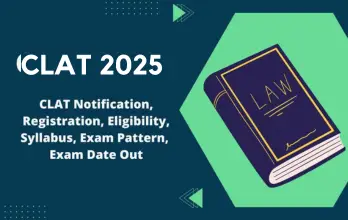
What is the CLAT Exam and why it’s a difficult nut to crack?
The Common Law Admission Test (CLAT) is a central national level law entrance test for admissions to 23 National Law Universities in India (NLU) except NLU DELHI which takes admissions via its separate AILET exam in India. CLAT is now the single largest law entrance exam in India and is preferred by those passing the 12TH Standard who opts to take Law as a career option. Most private and self-financed law schools in India also use these scores for law admissions. With a selection ratio of just 0.5%, the exam is as tough as it can get and most students underestimate it. The preparation strategy for the exam itself requires many trials by the students as it’s not a conventional exam but a very dynamic one. The exam requires the student not only to be aware of current affairs but also develop a flair for law writings and legal knowledge. The study pattern required is also not homogenous like for example NEET. NEET has 3 sections - Physics, Biology, Chemistry equally divided and student can plan to give attention according to his strengths and weakness. CLAT is not like NEET or IITJEE, Period. The exam is unequally divided and Legal Reasoning takes the highest proportion of time in exam as well marks. If you do not like Legal section, you cannot clear the CLAT exam. Similarly, if you cannot read fast, then you will not be able to clear the English and Critical Reasoning portion of the exam in the required time limit. A significant portion of preparation time is taken by GK that comes from unexpected corners and person has to do the entire Current affairs of a year plus solid revision of static Gk topics. Add in all of the above, Quant and Newspaper for each single day and you are already looking at an exam which requires 5-6 hours of preparation each day for solid results. Now let’s come to the burning question which must have arisen in your mind by now on CLAT.
How to Clear CLAT Exam in 2026?
English Section
The first section which comes in the exam and it requires its own mini-strategy. Questions are predominantly asked from Comprehensions which are fairly long and require a good analysis. The questions need to be answered by the candidates in a max time span of 25 minutes in order to complete the remaining sections on time. The English section is among one of the three most important reading sections of CLAT which include Legal and Critical Reasoning. Apart from reading speed candidates have to master English Literary devices in order to score good marks in the exam. The first thing to do as a student is to check your comprehension reading speed. You can open this link and do any of the 150 passages in less than 8 mins with 90% accuracy. Try this for 5 English passages and you will come to know where you stand with regard to your reading speed. If the reading speed is too slow, try to find out the reason. It can be your vocabulary, it can be your limited reading list or it can be a confidence issue with regard to English. If you do have around 1 year, then you can increase your reading speed at least twice what you possess currently.
Legal Section
The next most important section for CLAT exam is the Legal Reasoning section both by its depth as well as its size. The Lengthiest section with the highest number of marks given in a particular section i.e. 40 marks. The section has intense focus on questions ranging from Current Legal issues like Criminal Procedure Identification Act, Right to Privacy to standard questions on topic of Cruelty given in Indian Penal Code. The section requires absolute mastery over legal terms and Legal theory. After mastering the basics, candidate has to revise current affairs from legal new sites such as a Live Law, Bar and Bench as questions are asked from burning topics in CLAT. The tip to master the Legal section lies in the ability to master quick reading speed and fast analysis of legal terms in passages. The section can easily fetch 30+ marks in CLAT as more than 75% questions are of moderate or easy level. The ability to crack CLAT is directly proportional to cracking the legal section in CLAT exam.
Critical Reasoning
Critical Reasoning in CLAT is confused by many to be identical to English but it is not the same. The Critical Reasoning section of CLAT requires analytical and reasoning abilities in a very short span of time.
“Analytical and critical reasoning is the rational process through which you “obtain, interpret, and use knowledge, facts, and data”, while exercising logical thinking in analyzing issues and making proper decisions, to ultimately solve problems.” – McGill University
The answer has to be deciphered from the passage in exam and the task is not easy considering the time provided. Let’s say one manages to mark English and Legal section in 1 hour 10 minutes, then he has only 30 minutes for critical reasoning as well. The questions come from a wide range of topics and general reading abilities will be an aid in this section of CLAT exam as well. The first and foremost thing a student can do to learn about critical reasoning is to go first watch the free 60 videos on our Youtube channel and increase the marks in this section. The next thing that can be done is reading from GMAT study materials which are available in abundance on Internet. ‘Do the work’ is the mantra for this section as it gets better with each question. Yes each Question.
Current Affairs
This section of CLAT is most unpredictable and questions can come from any prominent news portal, newspaper or Static GK. The ideal time for preparation for this section of CLAT is one year with a time devotion of one hour each. A candidate may devote around 15 minutes each day for static Gk portion of CLAT which can come in handy if the paper is scheduled on those lines.
- The current affairs of CLAT can be covered from various sources like Smartkeeda GK updates, test series, Current affairs modules, newspapers, websites etc.
- Basic knowledge of Static Gk will be a great advantage in taking your scores to the next level.
- One of the best GK tip is to make a habit of reading the newspaper daily.
- Do not try to remember everything from everywhere. Keep a list of reading list for GK confined to 2 or max 3 resources and revise it.
- The art of note making is indispensible and you need to make short notes for awards, ceremonies and important indexes and indices.
Mathematics
This section of Maths in CLAT is done only by less than 10% candidates in paper with 80% accuracy or more and the precise reason for the same is the complex nature of questions asked in the desired time frame. The section requires extreme practice as questions are asked from DI sets, charts and graphs. The section of maths in CLAT is the deciding factor in the final selection of top 3 Universities in CLAT as there is fierce competition in those brackets of colleges.
The resources that you can use for good scores in Maths section for CLAT exam are – Free Pdf’s provided by smartkeeda, Tests for entire topic coverages etc.
List of Free Material Links
Reading comprehensions for CLAT [Click Here]
DI for CLAT [Click Here]
Advanced DI for CLAT [Click Here]
Current Affairs for CLAT [Click Here]
Logical Reasoning for CLAT [Click Here]
Legal Aptitude blog for CLAT [Click Here]

Author : Rohit Sharma
Hi, I am Rohit Sharma, the head of the Law exams vertical at Smartkeeda and an alumnus of NLU Punjab. Having successfully cleared the CLAT exam twice, I am currently engaged in teaching Legal Reasoning on the LawEx YouTube channel. Moreover, I contribute by writing blogs that are specifically tailored to the CLAT exams.





